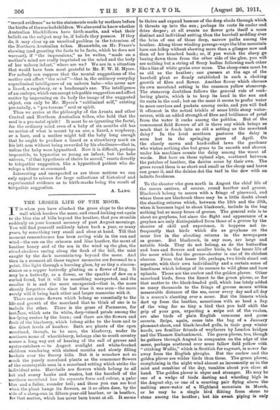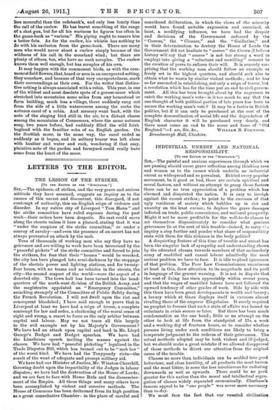THE LESSER LIFE OF THE MOOR.
IT is when you have climbed the grass slope to the stone wall which borders the moor, and stand looking out again to the blue rim of hills beyond the heather, that you stumble suddenly on your keenest memory of past August mornings. You will find yourself suddenly taken back a year, or many years, by something very small and close at hand. Till that moment remembrance has been roving wide in the sun and wind—the sun on the crimson and lilac heather, the scent of heather honey and of the sea in the wind up the glen, the cloud-shadows racing along the flank of the hill, the mist caught by the dark mountain-top beyond the moor. And then in a moment all these vaguer memories are focussed to a point, like light through a burning glass, by so tiny a circum- stance as a copper butterfly glinting on a flower of ling. It may be a butterfly, or a flower, or the sparkle of dew on a curled frond, but it will be something unexpected, and the smaller it is and the more unexpected—that is, the more cleanly forgotten since the last time it was seen—the more surely will it bring back other and larger memories with it.
There are some flowers which belong so essentially to the life and growth of the moorland that to think of one is to include the other. There is the grass of Parnassus, for instlece, which sets its white, deep-veined petals among the low-lying rushes by the burn; and there are the flowers and fruit of the blaeberry, which belong alike to the burn and to the driest levels of heather. Both are plants of the open moorland, though, to be sure, the blaeberry, under its southern name of whortleberry, belongs also to south country scenes a long way out of hearing of the call of grouse and oyster-catchers — to August sunlight and white-frocked children wandering with stained mouths and slowly filling baskets over the Surrey hills. But it is somehow not so much the purely moorland plants as the commoner flowers of the countryside seen in a moorland setting which strike the individual note. Harebells are flowers which belong to all hot and sunny banks and wastes, but the harebell of the northern moorland has its separate form and colour, a paler blue and a fuller, rounder bell ; and these you can see best when the plant hangs its flowers, as it so often does, by the side of a sheep-run in fifteen-year-old heather, or in heather, for that matter, which has never been burnt at all. It seems to thrive and expand because of the deep shade through which it thrusts up into the sun ; perhaps its roots lie cooler and drive deeper; at all events no flower gets itself a more distinct and individual setting than the harebell nodding over the brim of one of those deep, narrow paths among the heather. Along those winding passage-ways the blue mountain hare can lollop without showing more than a glimpse now and then of her hunched back; or, if you watch the sheep go baaing down them from the other side of the glen, you will see nothing but a string of fleecy bodies following each other like a line of white grubs over moss. The sheep-runs must be as old as the heather ; one guesses at the age of the harebell plant so firmly established in such a choking growth of fibre and flower. Another flower which chooses its own moorland setting is the common yellow stonecrop. The stonecrop doubtless follows the general rule of rock- loving plants, which is to keep its head in the sun and its roots in the cool; but on the moor it seems to prefer water to mere crevices and pockets among rocks, and you will find it oftenest in the actual trickle of some little stony water- course, with an added strength of fibre and brilliance of petal from the water it sucks among the pebbles. But of the commonest field flowers of all is there any which brings so much that is fresh into so old a setting as the moorland daisy? In the level southern pastures the daisy is soon lost in the springing grass of April. On the closely mown and hard-rolled lawn the gardener who wishes nothing else but grass to lie smooth and shaven under his machines counts the daisy among the worst of weeds. But here on these upland alps, scattered between the patches of heather, the daisies come by their own. The grass round them is as short and small as the sheep and hares can graze it, and the daisies dot the turf in the dew with an infinite freshness.
To the shooter who goes north in August the chief life of the moors centres, of course, round heather and grouse. Blackcock belong to moors with a fringe of pinewood, and where there are blackcock there may be a little doubt about the shooting returns which, between the 12th and the 20th, when it becomes legal to shoot blackcock, include in the bag nothing but so many brace of grouse. The general rule is to shoot no greyhens, but since the flight and appearance of a greyhen are only distinguished from those of a grouse by the shooter of skill and experience, it happens not in- frequently that birds which die as greyhens on the moor live in the shooting returns in the newspapers as grouse. But blackcock, in any case, are large and notable birds. They do not belong, as do the butterflies and bees and flowers and smaller birds, to the lesser life of the moor which for the grouse-shooter is one of its chiefest charms. From that lesser life, perhaps, two birds stand out separate, with their own individuality and a certain sense of loneliness which belongs of its essence to wild glens and bare uplands. Those are the curlew and the golden plover. Other moorland birds, from the linnet to the green plover, or for that matter to the black-headed gull, which has lately added so many thousands to the fringe of grouse moors within measurable distance of the sea, occur every day and all day in a season's shooting over a moor. But the linnets which dart up from the heather, sometimes with so loud a flap of the wing for so tiny a bird that you half shift the grip of your gun, expecting a snipe out of the rushes, are also birds of plain English commons and gorse coverts. Snipe, again, come into the bag of a January pheasant-shoot, and black-headed gulls, in their grey winter hoods, are familiar friends of wayfarers by London bridges and the Thames Embankment. The green plover, too, though he gathers through August in companies on the edge of the moor, perhaps scattered over some fallow field yellow with " stinking Wullie," which is Scottish for ragwort, is never far away from the English ploughs. But the curlew and the golden plover are wilder birds than these. The green plover, complaining in the night wind almost as incessantly as in the mist and sunshine of the day, tumbles about you close at hand. The golden plover is shyer and stranger. He may be one of a wedge of birds darting and wheeling high in the August sky, or one of a courting pair flying above the melting snow-water of a Highland mountain in March, or he may be a single bird flitting from stone to stone among the heather ; but his sweet piping is only less mournful than the redshank's, and only less lonely than the call of the curlew. He has learnt something of the range Of a shot gun, but for all his wariness he figures too often in the game-book as "various." His piping ought to ensure him a better fate. As for the curlew, his whistle has nothing to do with his exclusion from the game-book. There are many men who would never shoot a curlew simply because of the wildness of his call in the moorland wind ; but there are plenty of others, too, who have no such scruples. The curlew knows them well enough, but has scruples of his own.
It may happen with the commonest birds, as with the coin- monestfield flowers, that, heard or seen in an unexpected setting, they somehow, and because of that very unexpectedness, mark their surroundings as their own. For the writer that distinc- tive setting is always associated with a robin. This year, in one of the wildest and most desolate spots of a grouse-moor which stretched into mountains some miles from any homestead or farm building, much less a village, there suddenly rang out from the side of a little watercourse among the rocks the autumn carol of a robin. And memory went back, with the note of the singing bird still in the air, to a distant chasm among the mountains of Connemara., where the same autumn song, two years before, had suddenly filled the wild Irish bogland with the familiar echo of an English garden. On the Scottish moor, in the same way, the carol ended as suddenly as it began, and its solitary hearer was left alone with heather and water and rock, wondering if that easy, plaintive note of the garden and farmyard could really have come from the heart of the moor.



































 Previous page
Previous page